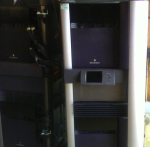loonvf wrote:
Hi Ian,
Thanks for the advise, this is very usefull indeed.
What surprises me is that you mention a Fuel being able to run Flame.
I never knew Fuels are capable of running discreet software at all.
Are you sure about this?
Or does anyone have experiense with Fuel and Flame or discreet?
Thanks in advance,
There's a FuelV10/FuelV12 licensing option coded into Flame 9 - whether or not they were ever sold is definitely a different story as I am fairly certain they were not.
If you don't need SDI I/Os a Fuel or modified Origin 350 with V12 makes an excellent Flame box, even for HD. If you do need SDI, you should probably get a Tezro as it has enough XIO slots to support both ODYSSEY graphics and SNOWBALL (the DMediaPro SDI I/O option). Two Origin 350s in NUMALink might also be able to achieve this configuration (V12 in one, SNOWBALL in the other), but I have not tested firsthand.
I just shovel uncompressed video imported and preprocessed elsewhere as frame sequences to and from my O350 Flame box, and this workflow works okay for me. I am not a professional user though - just a hobbyist having some fun. I'm using 3 internal disks across my 2 NUMALinked O350 chassis as Stone (via the Stone internal disk licensing method), and I get about 135MB/s which is decent enough for basic tasks. My quad 1Ghz R16Ks absolutely fly, especially compared to an Octane2.
The Fuel is definitely the most economical option (unless you can get lucky on some O350s) - you can generally get a mid-specced Fuel for less than a a comparable Octane2, and the Fuel is quieter and less power-hungry.
silicium wrote:
Easy to do if ffmpeg can decode video files from camera
Code:
ffmpeg -i camera_file.avi image%d.sgi
unfortunately neko_ffmpeg-SVN-r6775 is too outdated and does not have sgi image file format

I preprocess and convert on another (Linux) box, so it's not a worry

I do wish we had better ffmpeg support for IRIX and MIPS, both in regards to support and optimization, but it doesn't look likely.
 <>
<>









